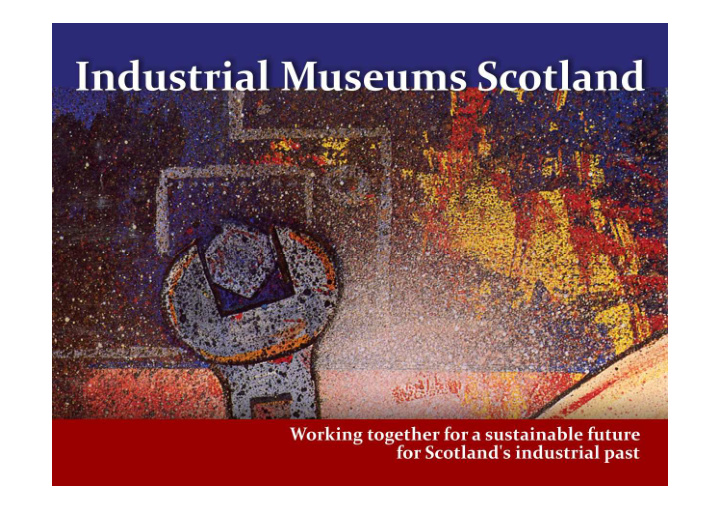



Industrial Museums Scotland Working together for a sustainable future for Scotland’s industrial collections
Life before IMS • Association of Independent Industrial Museums and Heritage Sites in Scotland. • An informal, un-constituted grouping of industrial museums established in the early 1980’s. • Led by Jim Arnold of New Lanark. • Guided and inspired by John Hume.
Early AIIMHSS meetings… • Were held in sheds on building sites…… • but only on grey, rainy days. • Considered the latest threat to existence…… • or the latest madcap proposal. • Offered mutual encouragement and support. • Local initiatives in absence of national action • Hunter-gatherers of the museum world • Or beyond the pale?
AIIMHSS members • New Lanark • Scottish Maritime Museum • Scottish Mining Museum(s) • Bo’ness Heritage and SRPS • Wanlockhead • Dalmellington and later…. • Summerlee (Heritage Trust) • Dundee Heritage • Almond Valley • Scottish Fisheries Museum
AIIMHSS action • “100 sites” booklet • Joint promotion • Exchanging knowledge • Provide a voice • Lobby for recognition • Lobby for funding • Lobby for survival
Plans and pleas • Miles Report (1986) recognised importance, and suggested structure for the sector. • 1989 - Community Programme ends. • Pattison (1999), warned of failure of museums. • 2001 - Survival funding to SMM, SMM & SFM • 2009 - Emergency funding to Mining Museum
Museums Think Tank
Museums Think Tank • “how to achieve a sustainable future for industrial museums has proved to be the most difficult area for the Think Tank to agree on. There is agreement, however, that our industrial heritage is important and that maintaining the status quo is not an option.”
Museums Think Tank • Recommends that government explicitly agrees direct funding to SMM, SMM & SFM. • Recommends that government supports the establishment of a federation of industrial museums whose members are encouraged to work together to achieve optimum efficiencies.
Industrial Museums Scotland • Memorandum of Understanding (2011) • Bringing together accredited independent museums with Recognised industrial collections, in order to promote sustainability. • Led by 3 museums receiving government funding; links to NMS, HS, and MGS
Our members • National Mining Museum Scotland • Scottish Fisheries Museum • Scottish Maritime Museum • Almond Valley • Dundee Heritage • Museum of Lead Mining • SRPS • The Museum of Scottish Lighthouses
Further members • Aberdeen Maritime Museum • Summerlee Museum of Scottish Industrial Life
IMS achievements so far…. • Joint reporting by lead members. • Volunteer coordinator intern, funded though MGS, shared by lead members. • Collections management software and equipment, funded by government. • IMS Coordinator – part-time post, funded through Recognition fund.
IMS: Where we are now • Collections and sites representing many of Scotland’s traditional industries (but with big gaps). • Collections and organisations that are based at original locations and rooted in communities. • Limited coordination between member museums (so far), with the rest of the museum community, the world of archives or with other heritage agencies. • Great variations in objectives, governance, sources of income, and the scale of challenge facing our museums. • Recognition that admission charges alone will never be sufficient to sustain an industrial museum.
IMS: diversity and similarity
Diversity: good ? • Museums draw income from a wide range of sources – not all drinking from the same trough. • There’s a wide range of expertise within the sector that might potentially be shared. • Interaction of different business models breeds cross-fertilisation of ideas and innovation
Diversity : bad? • Different business models have different development requirements. • ….and means less common ground for collaboration and collective action. • An imposed requirement to act collectively may be an additional burden.
IMS: What happens next? • How do we work together to “achieve optimum efficiencies” or “promote sustainability”? • Identify areas of common interest where collective action would be of mutual benefit. • Perhaps closer coordination between the 3 funded members; some sharing of functions? • Perhaps some voluntary alignment of policies and activities, inspired by a common vision. • Rather than impose uniformity, each would contribute to the vision in ways best suited to its culture and circumstances.
In thirty years time..? • Survival of structures and collections at their original sites? • Survival of specialist expertise, skills and equipment • Survival of specialist knowledge • Survival of public interest in defunct industries and past ways of life.
In thirty years time..? • A coordinated network of vigorous community based industrial museums operating as effective businesses. • Constantly evolving and re-interpreting the past to serve the issues of the day. • Centres of industry-specific knowledge; a focus for research and learning; a shop-window for other heritage partners. • Encouraging practical participation by new generations.
What we need • Recognition, and business development support appropriate to a museum’s needs. • A level playing field with national museums and other nationally funded organisations • Convergence of heritage interests; setting aside of professional boundaries. • A shared, overarching vision for industrial heritage in Scotland.
the optional gorilla slide.
Recommend
More recommend